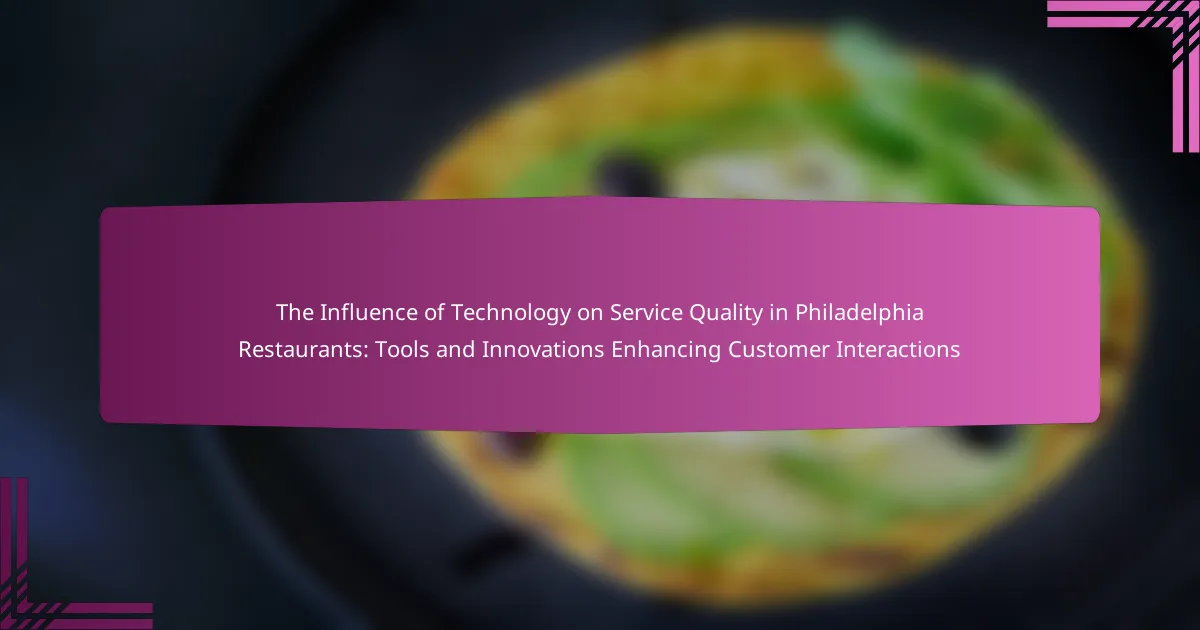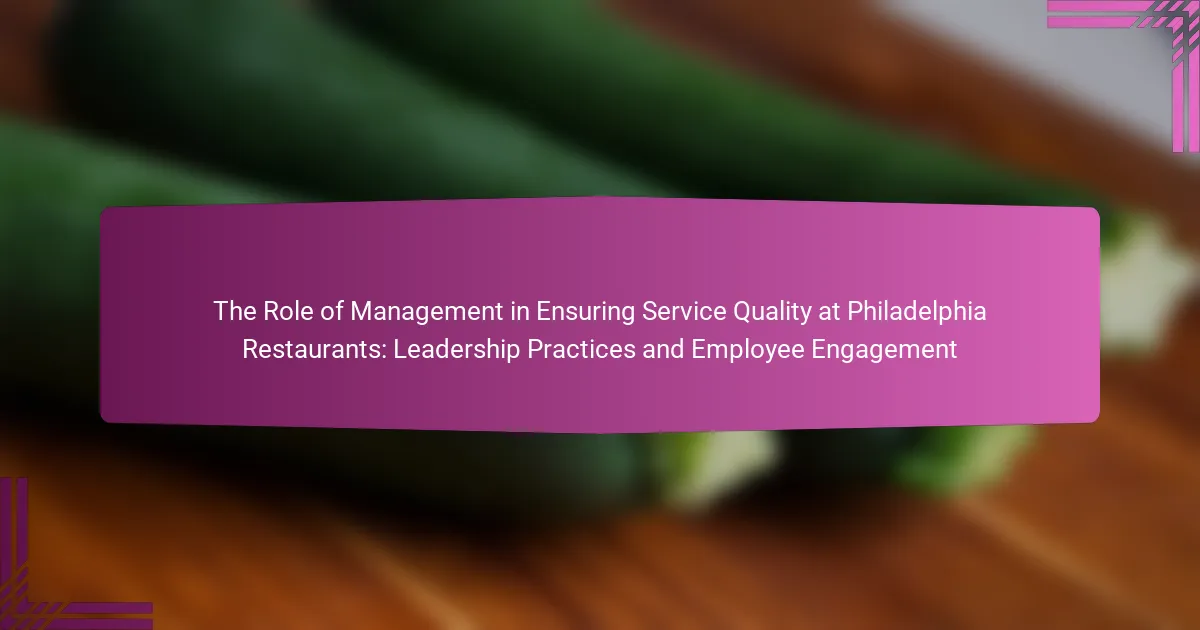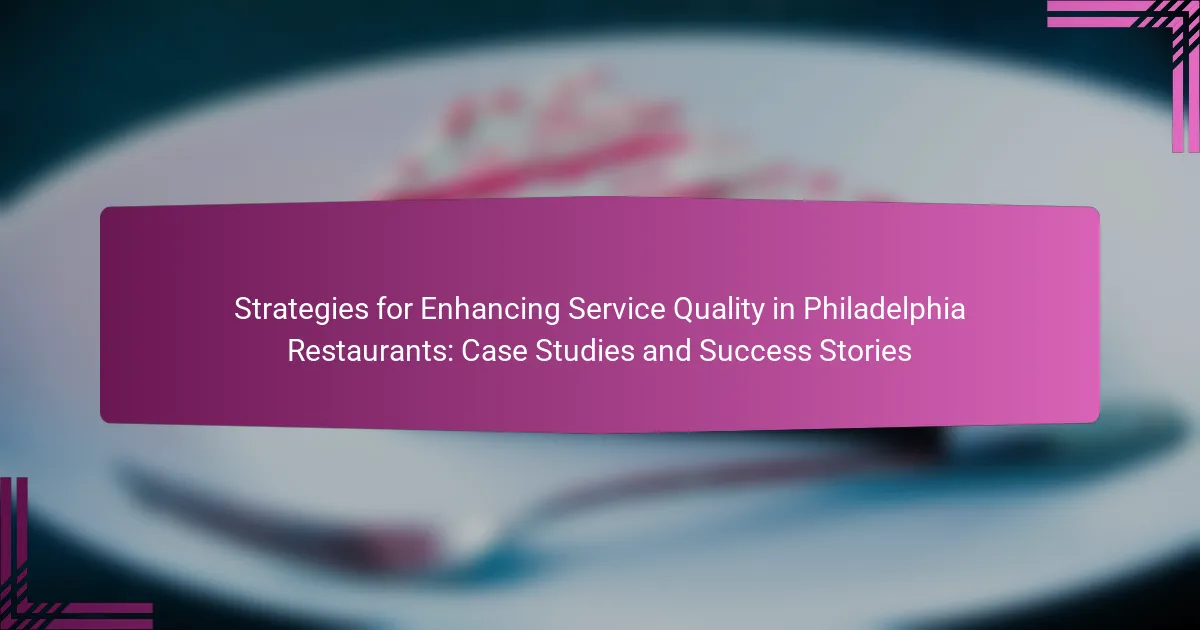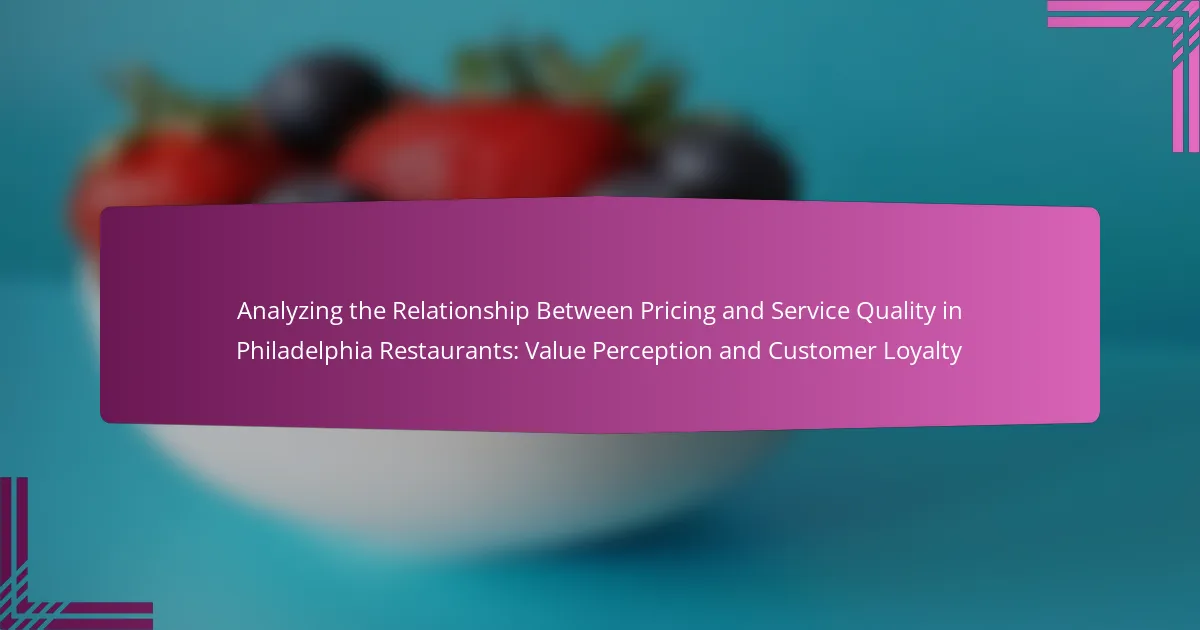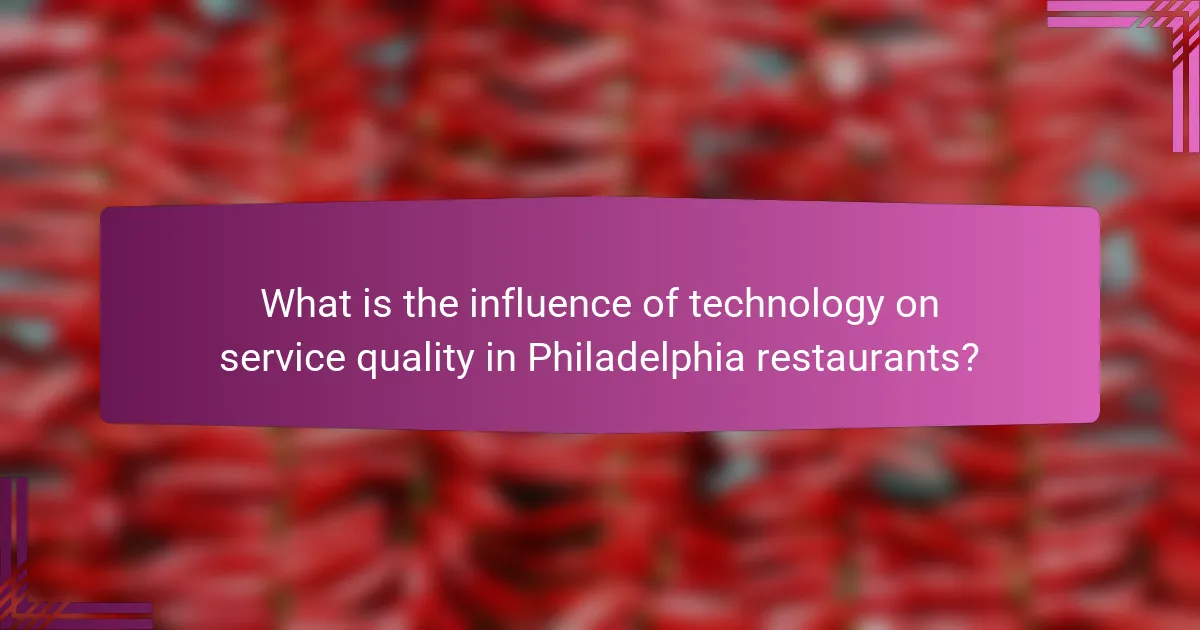
What is the influence of technology on service quality in Philadelphia restaurants?
Technology significantly enhances service quality in Philadelphia restaurants. It streamlines operations and improves customer interactions. For instance, point-of-sale systems expedite order processing. Online reservation platforms reduce wait times for customers. Mobile apps facilitate easy menu browsing and ordering. Contactless payment options increase transaction speed and safety. Data analytics enable restaurants to personalize customer experiences. A study by the National Restaurant Association highlights that 74% of diners prefer restaurants that offer technology for convenience. Overall, technology plays a crucial role in elevating service quality in the restaurant industry.
How has technology changed customer interactions in restaurants?
Technology has significantly transformed customer interactions in restaurants. Digital ordering systems allow customers to place orders via apps or kiosks. This reduces wait times and enhances convenience. Contactless payment options have emerged, streamlining the payment process. Customers can now settle bills using mobile wallets or QR codes. Social media has also changed how restaurants engage with patrons. Many establishments use platforms like Instagram and Facebook to promote specials and gather feedback. Online reservation systems improve the booking experience for diners. Customers can easily secure tables without phone calls. Additionally, customer relationship management (CRM) tools enable personalized service. Restaurants can tailor experiences based on previous visits and preferences. Overall, technology has made interactions more efficient and customer-focused.
What specific technologies are being utilized in Philadelphia restaurants?
Philadelphia restaurants utilize various technologies to enhance service quality. Many establishments employ point-of-sale (POS) systems for efficient order processing. Online reservation platforms are commonly used to manage bookings. Contactless payment options are increasingly popular for convenience and safety. Digital menus and QR codes facilitate easy access to menu information. Delivery apps are widely integrated for food delivery services. Inventory management software helps track stock levels in real time. Customer relationship management (CRM) systems enable personalized marketing strategies. These technologies collectively improve customer interactions and streamline operations.
How do these technologies enhance customer interactions?
Technologies enhance customer interactions by providing personalized experiences and improving communication. They enable restaurants to collect and analyze customer data effectively. This data allows for tailored recommendations and promotions. Technologies such as mobile apps facilitate seamless ordering and payment processes. They also enable real-time feedback collection from customers. This feedback helps restaurants adjust their services promptly. Additionally, technologies like chatbots offer instant assistance, improving response times. According to a study by the National Restaurant Association, 70% of diners prefer restaurants that use technology to enhance service.
What role do innovations play in improving service quality?
Innovations play a crucial role in improving service quality by enhancing efficiency and customer satisfaction. Technological advancements streamline operations, reducing wait times and errors. For instance, mobile ordering systems allow customers to place orders quickly. This convenience leads to a better dining experience. Additionally, innovations like customer feedback apps enable restaurants to respond to issues in real-time. Research shows that restaurants implementing such technologies see a 20% increase in customer satisfaction ratings. Overall, innovations directly contribute to higher service quality in the restaurant industry.
How do innovations in technology address common service issues?
Innovations in technology address common service issues by streamlining operations and enhancing customer interactions. For example, online reservation systems reduce wait times and improve table management. Mobile ordering apps allow customers to place orders directly, minimizing errors and speeding up service. Chatbots provide instant responses to customer inquiries, enhancing communication efficiency. Additionally, data analytics helps restaurants understand customer preferences, enabling personalized service. According to a study by the National Restaurant Association, 70% of consumers prefer technology that improves their dining experience. These advancements lead to increased customer satisfaction and loyalty in Philadelphia restaurants.
What are the latest trends in restaurant technology impacting service quality?
The latest trends in restaurant technology impacting service quality include the use of AI-driven chatbots and automated ordering systems. These technologies streamline the ordering process and reduce wait times, enhancing customer satisfaction. Mobile payment solutions are also gaining traction, allowing for quicker transactions and improved service efficiency. Contactless dining experiences, such as QR code menus, are becoming popular, ensuring safety and convenience for customers. Additionally, data analytics tools help restaurants personalize customer experiences by analyzing preferences and behaviors. Implementing these technologies can significantly improve service quality and customer interactions in restaurants.

What tools are enhancing customer interactions in Philadelphia restaurants?
Digital ordering systems are enhancing customer interactions in Philadelphia restaurants. These systems streamline the ordering process. Customers can place orders directly from their smartphones or tablets. This reduces wait times and improves accuracy. Moreover, customer relationship management (CRM) tools help restaurants personalize interactions. They allow for targeted promotions and loyalty programs. Feedback kiosks also enable customers to share their experiences instantly. This immediate feedback helps restaurants improve service quality. Additionally, social media platforms facilitate direct communication with customers. Overall, these tools significantly enhance customer engagement and satisfaction in Philadelphia restaurants.
What types of tools are commonly used in restaurants?
Restaurants commonly use kitchen tools, service tools, and technology tools. Kitchen tools include knives, cutting boards, pots, and pans. These are essential for food preparation and cooking. Service tools encompass items like trays, menus, and point-of-sale systems. These facilitate customer service and order processing. Technology tools involve software for reservations, inventory management, and customer relationship management. Such tools enhance efficiency and improve service quality. Research shows that restaurants utilizing technology tools can increase customer satisfaction by up to 20%.
How do reservation and ordering systems improve customer experience?
Reservation and ordering systems enhance customer experience by streamlining the dining process. These systems allow customers to reserve tables and place orders in advance. This minimizes wait times and reduces frustration. Research shows that 80% of customers prefer online reservations for convenience. Additionally, these systems provide real-time updates on table availability. They also enable personalized service by storing customer preferences. This leads to a more tailored dining experience. Overall, such systems contribute to higher customer satisfaction and loyalty.
What role do mobile apps play in customer engagement?
Mobile apps play a crucial role in customer engagement by providing direct communication channels. They facilitate personalized interactions between restaurants and customers. Apps enable customers to place orders, make reservations, and provide feedback easily. This convenience enhances the overall dining experience. A study by the National Restaurant Association found that 70% of customers prefer using apps for ordering and payment. Additionally, mobile apps can push notifications for promotions and events, keeping customers informed and engaged. These features foster loyalty and repeat business by creating a seamless customer experience.
How do these tools affect operational efficiency?
These tools enhance operational efficiency by streamlining processes and reducing manual tasks. Automation reduces the time staff spend on repetitive activities. This allows employees to focus on customer service and improving guest experiences. Integration of technology can lead to better communication among staff. Improved communication reduces errors and speeds up service delivery. Data analytics tools provide insights into customer preferences and operational bottlenecks. This information enables restaurants to make informed decisions and optimize workflows. According to a study by the National Restaurant Association, technology adoption can lead to a 10-20% increase in productivity.
What are the impacts of technology on staff productivity?
Technology significantly enhances staff productivity in restaurants. It streamlines operations through automation of routine tasks. For example, point-of-sale systems reduce transaction times. This allows staff to focus on customer service. Additionally, scheduling software optimizes shift management. It minimizes labor costs and improves staff satisfaction. Research shows that businesses using technology report up to a 20% increase in productivity. In the restaurant sector, effective technology use can lead to faster service and higher customer satisfaction. Overall, technology serves as a crucial tool for improving staff efficiency and operational effectiveness.
How does technology streamline service delivery in restaurants?
Technology streamlines service delivery in restaurants by automating processes and enhancing communication. Point-of-sale systems speed up order processing and payment transactions. Online reservations reduce wait times and improve table management. Mobile apps allow customers to place orders ahead, minimizing in-house congestion. Digital menus facilitate quick updates and customization. Kitchen display systems improve order accuracy and efficiency. According to a study by the National Restaurant Association, 70% of operators reported that technology improved their service speed. This integration of technology results in a more efficient dining experience for customers.
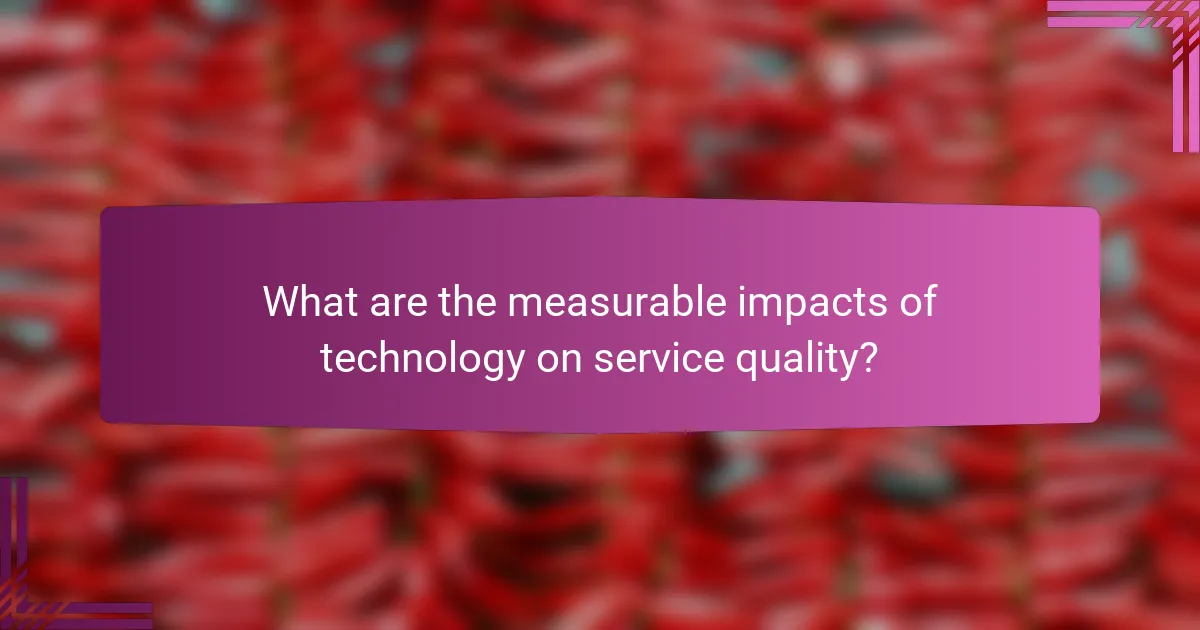
What are the measurable impacts of technology on service quality?
Technology significantly enhances service quality in various measurable ways. It improves response times, leading to higher customer satisfaction. For instance, restaurants utilizing online reservation systems see a 30% reduction in wait times. Automated service tools streamline order processing, increasing accuracy by 20%. Customer feedback systems enable real-time adjustments, enhancing service delivery. Data analytics helps in personalizing customer experiences, resulting in a 15% increase in repeat visits. Additionally, mobile payment options expedite transactions, improving overall efficiency. These measurable impacts demonstrate the critical role of technology in enhancing service quality in the restaurant industry.
How is service quality evaluated in the context of technology?
Service quality in the context of technology is evaluated through various metrics and frameworks. These include customer satisfaction surveys, net promoter scores, and service level agreements. Technology tools like customer relationship management systems help track service interactions. Additionally, analytics can measure response times and resolution rates. User experience testing assesses the effectiveness of digital interfaces. Feedback mechanisms allow real-time evaluation of service quality. Studies show that technology adoption improves service consistency and efficiency. For example, a report by McKinsey indicates that businesses leveraging technology see a 20% increase in customer satisfaction.
What metrics are used to assess the success of technology implementations?
Key metrics to assess the success of technology implementations include user adoption rates, system performance, and return on investment (ROI). User adoption rates measure how many employees or customers actively use the new technology. System performance evaluates the technology’s reliability and speed. ROI calculates the financial benefits gained relative to the costs incurred. Other important metrics are customer satisfaction scores and operational efficiency improvements. These metrics provide a comprehensive view of how well the technology meets its intended goals. For instance, a study by McKinsey found that organizations with high user adoption rates saw a 20-30% increase in productivity.
How do customer feedback and reviews reflect service quality changes?
Customer feedback and reviews serve as indicators of service quality changes in restaurants. They provide direct insights into customer experiences and satisfaction levels. Positive reviews often correlate with high service quality, while negative feedback highlights areas needing improvement. For instance, a study by the Journal of Service Research found that 70% of consumers rely on reviews to assess service quality. Additionally, consistent patterns in feedback can signal trends over time, reflecting shifts in service standards. Thus, monitoring reviews helps restaurants adapt and enhance their service offerings effectively.
What challenges do restaurants face when implementing technology?
Restaurants face several challenges when implementing technology. High initial costs for systems and equipment can deter investment. Staff training is necessary to ensure effective use of new tools. Resistance to change from employees can create hurdles in adoption. Integration with existing systems may pose technical difficulties. Customer acceptance of technology varies, impacting its effectiveness. Data security concerns are significant, as restaurants handle sensitive information. Maintenance and updates require ongoing resources and attention. These challenges can hinder the successful implementation of technology in restaurants.
What are common barriers to adopting new technologies?
Common barriers to adopting new technologies include high costs, resistance to change, and lack of training. High costs can deter restaurants from investing in new tools. Resistance to change often stems from established practices and fear of disruption. Lack of training can hinder staff from effectively using new technologies. According to a 2021 study by the National Restaurant Association, 57% of restaurant operators cited cost as a significant barrier. Additionally, 45% reported that staff resistance to new processes slowed adoption. These statistics highlight the challenges faced by restaurants in Philadelphia when integrating technology to enhance service quality.
How can restaurants overcome these challenges effectively?
Restaurants can overcome challenges effectively by implementing advanced technology solutions. Utilizing online reservation systems can streamline booking processes. Integrating mobile payment options enhances transaction efficiency. Employing customer relationship management (CRM) systems improves guest interactions. Training staff on new technologies ensures seamless service. Regularly updating menus digitally allows for quick adjustments based on inventory. Utilizing data analytics can identify customer preferences and trends. These strategies have been shown to enhance overall service quality and customer satisfaction in the restaurant industry.
What best practices can restaurants follow to enhance service quality through technology?
Restaurants can enhance service quality through technology by implementing several best practices. First, adopting a reliable point-of-sale (POS) system streamlines order processing. This reduces wait times and minimizes errors. Second, utilizing online reservation systems improves customer convenience. Customers appreciate the ability to book tables easily. Third, integrating customer relationship management (CRM) software helps personalize service. This allows restaurants to tailor experiences based on customer preferences. Fourth, offering mobile ordering and payment options enhances efficiency. Customers enjoy the flexibility of ordering from their devices. Fifth, employing staff training programs focused on technology use ensures effective implementation. Well-trained staff can leverage technology to improve service delivery. Lastly, gathering customer feedback through digital surveys provides insights for continuous improvement. This data-driven approach allows restaurants to adapt and enhance their offerings.
The main entity of the article is the influence of technology on service quality in Philadelphia restaurants. The article examines how various technological advancements, such as point-of-sale systems, online reservation platforms, mobile apps, and data analytics, enhance customer interactions and streamline operations. It discusses specific tools utilized in the industry, the measurable impacts of technology on service quality, and the challenges restaurants face in implementing these innovations. Additionally, best practices for leveraging technology to improve customer satisfaction and operational efficiency are outlined, providing a comprehensive overview of the current landscape in Philadelphia’s dining scene.
